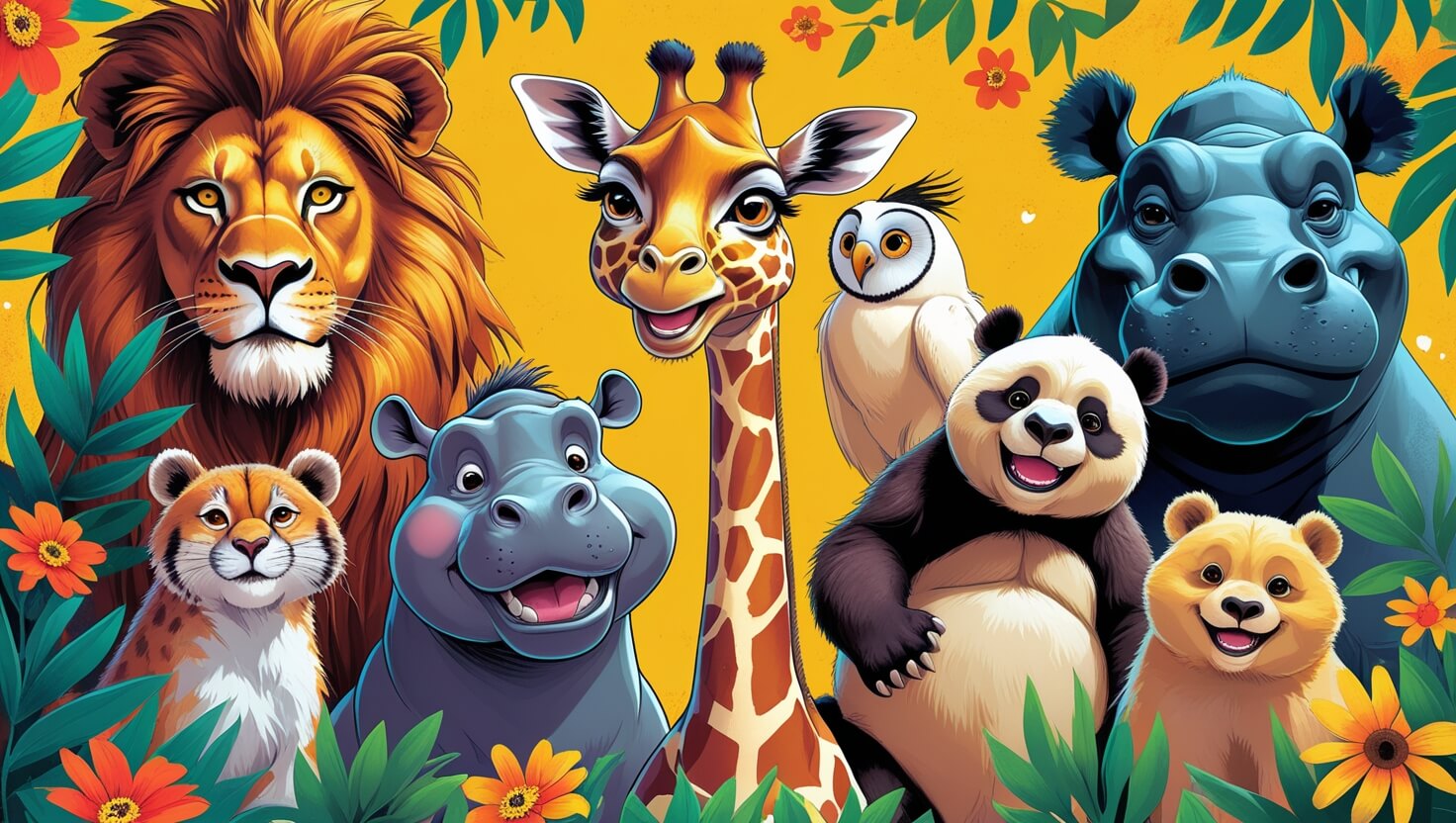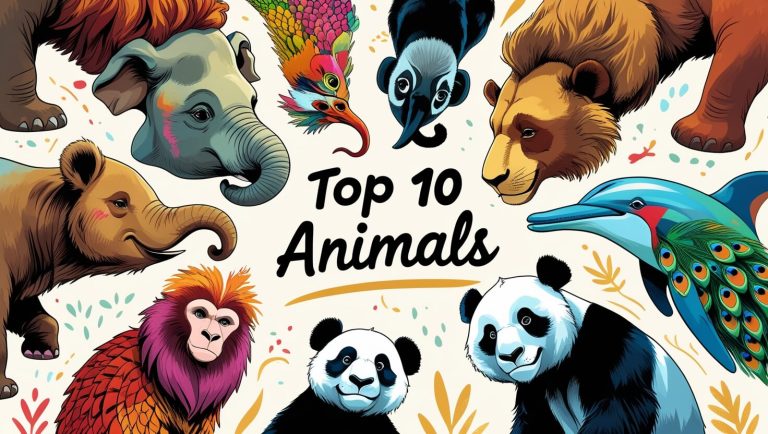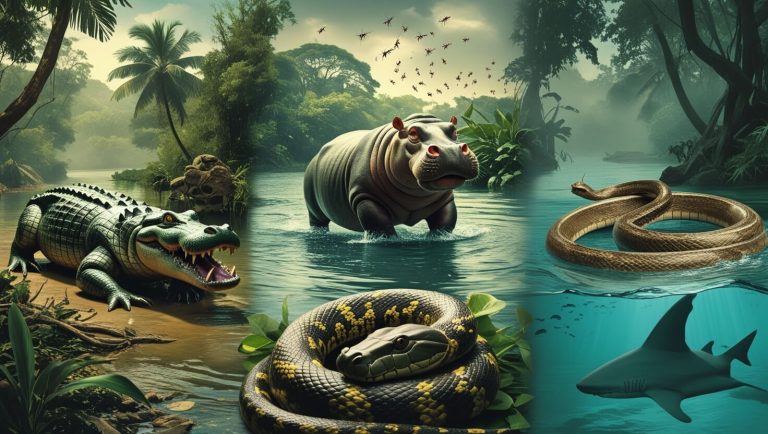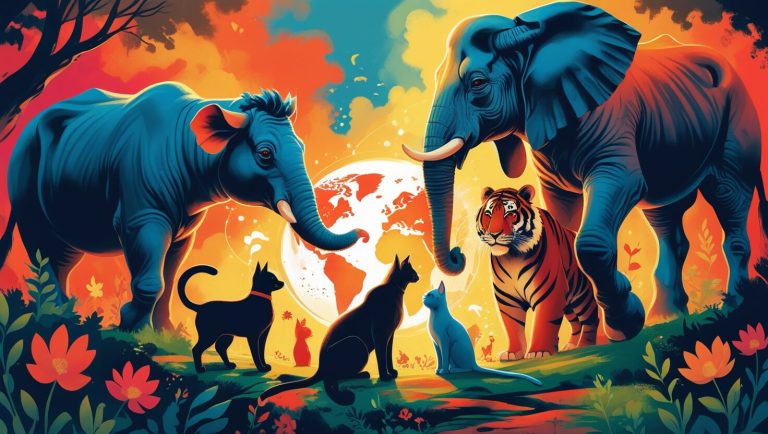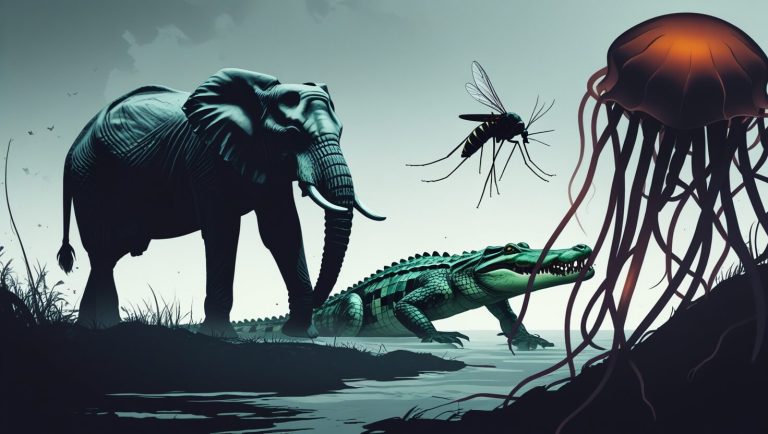Meet the Top 10 Favorite Animals on the Planet
Ever since I was a kid, animals have fascinated me. Whether it was watching documentaries with wide-eyed curiosity, visiting the zoo, or growing up with pets, my love for animals has only grown deeper over time. There’s something magical about the animal kingdom — its sheer diversity, the mystery of animal intelligence, and the raw beauty of wildlife.
This blog post is a tribute to that love. I’m sharing my top 10 favorite animals, not just because of how they look, but because of what they represent — intelligence, strength, loyalty, uniqueness, and pure wonder. Some are common companions; others are exotic creatures most of us will only ever see in pictures or documentaries. But every one of them has captured my imagination and my heart in some way. Let’s dive in!
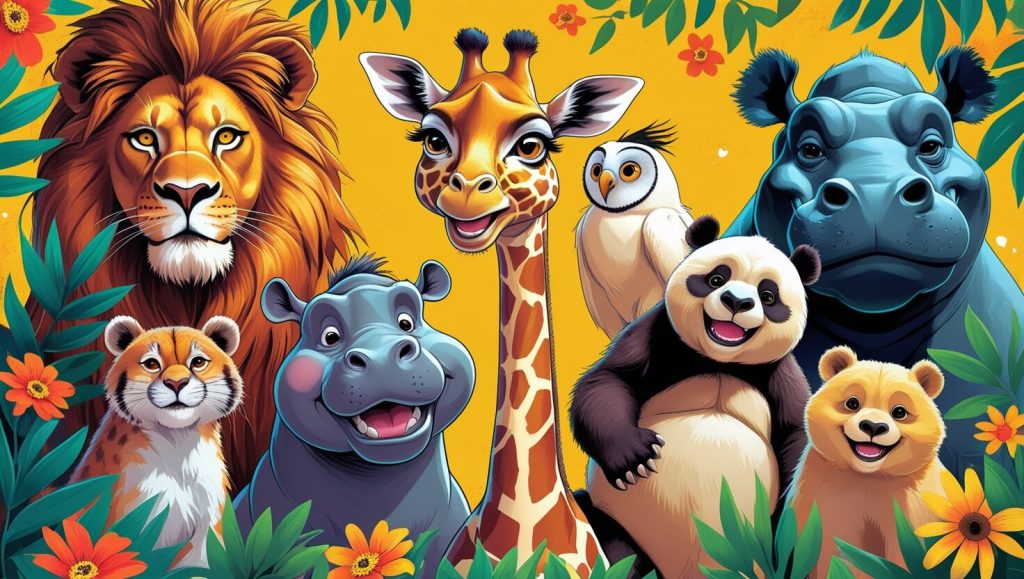
What Makes an Animal a “Favorite”?
Picking favorite animals isn’t exactly scientific — it’s emotional, personal, and sometimes even nostalgic. My criteria included how the animal behaves, its relationship with humans, intelligence, appearance, and even cultural symbolism.
Some of the animals I’ve chosen are known for their beauty or power, others for their gentle nature or quirky habits. A few of them have played roles in my own life. And while there are thousands of fascinating species on Earth, these ten stand out for me.
My Top 10 Favorite Animals
This list is a celebration of ten of the most popular and beloved animals on the planet. We’ll explore what makes them so special, learn some cool facts, and discover why they have captured our hearts. This isn’t a strict ranking from one to ten—it’s more like a collection of fantastic favorites! Let’s dive in.
1. The Dog: Humanity’s Best Friend
It’s almost impossible to imagine a world without dogs. For thousands of years, dogs have been by our side. They are not just pets; they are family members, protectors, helpers, and loyal companions.
Why We Love Them:
Dogs are famous for their unconditional love and loyalty. They are always happy to see you, whether you’ve been gone for five minutes or five hours. Their ability to understand human emotions is amazing. They can sense when we are sad and will often come to comfort us.
Cool Facts:
- Super Sniffers: A dog’s sense of smell is anywhere from 10,000 to 100,000 times stronger than ours! This is why they are used to sniff out drugs, find missing people, and even detect diseases like cancer.
- Many Breeds: There are hundreds of different dog breeds, from tiny Chihuahuas to giant Great Danes. This means there’s a perfect dog for almost every person and lifestyle.
- Smart Cookies: Dogs are very intelligent and can learn many commands and tricks. Some of the smartest breeds, like Border Collies, can understand over 1,000 words!
2. The Cat: The Graceful and Independent Companion
Cats are the other most popular pet in the world. While dogs are energetic friends, cats are often calm, graceful, and beautifully independent. Their mysterious nature is a big part of their charm.
Why We Love Them:
People love cats for their elegance, their soft purring, and their funny, playful personalities. Watching a cat chase a laser pointer or pounce on a toy never gets old. They offer affection on their own terms, which makes their purrs and cuddles feel like a special gift.
Cool Facts:
- Purr Power: Scientists aren’t 100% sure how or why cats purr, but it’s believed it’s not just a sign of happiness. Cats also purr when they are hurt or scared, and the vibrations may actually help heal their bones and tissues!
- Great Climbers: A cat’s claws are perfect for climbing trees. However, because their claws curve backward, they can’t climb down headfirst. This is why you sometimes see a cat stuck in a tree—it has to back down slowly.
- Communication Experts: Cats rarely “meow” at other cats. Instead, they developed this sound almost exclusively to communicate with humans.
3. The Dolphin: The Smart and Playful Swimmer
Dolphins are often seen as the dogs of the sea because they are so intelligent and playful. These marine mammals are a symbol of joy, freedom, and intelligence.
Why We Love Them:
Their constant “smile” and their love for playing in the waves make them a joy to watch. They are known for being curious about humans and have even been known to protect people from sharks. Their intelligence and complex social groups fascinate scientists.
Cool Facts:
- Echolocation: Dolphins use a natural sonar called echolocation. They make clicking sounds that bounce off objects and return to them. This helps them “see” a picture of their surroundings, even in dark or murky water.
- Team Players: Dolphins work together in amazing ways. They can hunt in groups to herd fish and will often help a sick or injured member of their pod by pushing it to the surface to breathe.
- Half a Brain: Dolphins sleep with one half of their brain at a time. This allows them to continue swimming, come up for air, and stay alert for danger even while they are resting.
4. The Elephant: The Gentle Giant
Elephants are the largest land animals on Earth, but they are also known for their gentle nature, strong family bonds, and incredible intelligence. They are a symbol of wisdom and strength in many cultures.
Why We Love Them:
We are in awe of their size and power, but we are touched by their emotional depth. Elephants show grief, joy, and compassion. They have famous memories and can remember other elephants and places for many, many years.
Cool Facts:
- Trunk Talent: An elephant’s trunk is one of the most amazing body parts in the animal kingdom. It is a nose and an upper lip combined, containing over 40,000 muscles! They use it to breathe, smell, drink, grab food, and even greet each other.
- Thick Skin: An elephant’s skin is up to one inch thick, but it is also very sensitive. They often cover themselves in mud to protect their skin from sunburn and bug bites.
- Family First: Elephant families are led by the oldest and wisest female, called the matriarch. The whole herd works together to care for and protect the adorable baby elephants.
5. The Penguin: The Tuxedo-Wearing Bird
Penguins are birds that cannot fly, but they have become expert swimmers instead. Their formal black and white feathers look like a little tuxedo, making them one of the most stylish and charming animals.
Why We Love Them:
We love their funny, waddling walk on land and their lightning-fast speed in the water. They seem both clumsy and graceful at the same time. Their dedication to their partners and their chicks is also very heartwarming.
Cool Facts:
- Super Swimmers: While they waddle on ice, penguins are fantastic swimmers. They can leap out of the water to breathe, a move called “porpoising,” and some species can swim up to 15 miles per hour.
- Keeping Warm: To survive the freezing temperatures of Antarctica, Emperor Penguins huddle together in giant groups. They take turns moving to the warm center of the huddle so no one gets too cold.
- Stone Proposal: Male Adelie penguins will present a smooth, perfect pebble to a female they like. If she accepts the pebble, they become a mating pair. It’s like giving an engagement ring!
6. The Owl: The Wise and Silent Hunter
With their big, forward-facing eyes and mysterious nature, owls have long been symbols of wisdom and knowledge. These nocturnal birds of prey are fascinating and a little bit magical.
Why We Love Them:
We are captivated by their unique appearance and their silent, ghost-like flight. Their ability to turn their heads almost all the way around seems like a superpower. They represent mystery and the hidden secrets of the night.
Cool Facts:
- Silent Flight: An owl’s feathers have special edges that break up turbulence, allowing them to fly almost silently. This helps them sneak up on their prey without being heard.
- Powerful Eyes: Owls can’t move their eyes in their sockets because they are tube-shaped. Instead, they have extra bones in their neck that let them turn their head up to 270 degrees!
- Not So Wise: While we call them “wise,” owls are actually not smarter than other birds like crows or parrots. The myth probably started in ancient Greece, where the owl was a symbol for Athena, the goddess of wisdom.
7. The Tiger: The Striped and Powerful Big Cat
Tigers are the largest of the big cats and one of the most powerful and beautiful predators in the world. Their striking orange coat with black stripes is instantly recognizable and admired.
Why We Love Them:
Tigers represent raw power, beauty, and wilderness. They are solitary and majestic creatures that command respect. Each tiger’s stripe pattern is unique, like a human fingerprint, making every single one special.
Cool Facts:
- Excellent Swimmers: Unlike most cats, tigers love water. They are strong swimmers and will often play and lie in lakes and rivers to cool off.
- Powerful Roar: A tiger’s roar is so powerful and deep that it can temporarily paralyze the animal hearing it. This is called “sonic paralysis.”
- Conservation Icons: Sadly, tigers are endangered. They are a keystone species, which means protecting them helps protect all the other animals and plants in their entire ecosystem.
8. The Panda: The Bamboo-Loving Bear
With their black-and-white coloring and clumsy, gentle behavior, Giant Pandas are one of the most universally loved animals. They are a global symbol of conservation efforts.
Why We Love Them:
Pandas seem like real-life teddy bears. Their round faces and playful antics, like rolling down a hill, are incredibly cute. We also love a success story, and the panda’s journey from being endangered to vulnerable gives us hope for other species.
Cool Facts:
- Bamboo Diet: A panda spends 10-16 hours a day eating up to 40 pounds of bamboo! Even though they are classified as carnivores, bamboo makes up 99% of their diet.
- Special Thumb: Pandas have a special enlarged wrist bone that works like a thumb, helping them grip the bamboo stalks while they eat.
- Tiny Babies: A newborn panda cub is about the size of a stick of butter—only 1/900th the size of its mother! It is one of the smallest mammal newborns relative to its mother’s size.
9. The Sea Turtle: The Ancient Ocean Voyager
Sea turtles are ancient reptiles that have been swimming in our oceans since the time of the dinosaurs. They are graceful, peaceful, and determined creatures.
Why We Love Them:
There is something magical about watching a sea turtle glide effortlessly through the water. Their long migrations across entire oceans are an incredible feat of navigation. We also feel a deep connection to their life cycle, especially when baby turtles hatch and make their dangerous journey to the sea.
Cool Facts:
- Built-in Compass: Scientists believe sea turtles can sense the Earth’s magnetic field and use it like a map to navigate back to the very beach where they were born to lay their own eggs.
- Salty Tears: Sea turtles have special glands behind their eyes that remove excess salt from the water they drink, making it look like they are crying.
- Long Lifespans: Some sea turtle species can live for over 50 years, and some may even live to be more than 100 years old.
10. The Wolf: The Wild and Loyal Pack Animal
Wolves often get a bad reputation in stories, but in reality, they are highly social, intelligent, and family-oriented animals. They are the ancestors of our pet dogs but represent the untamed spirit of the wild.
Why We Love Them:
We admire their strong pack mentality and deep loyalty to their family. The sound of a wolf howl is one of the most beautiful and wild sounds in nature. They are a symbol of teamwork, wildness, and freedom.
Cool Facts:
- Howl Communication: Wolves howl to talk to each other. They howl to bring the pack together before a hunt, to warn other packs away from their territory, or just for fun!
- Complex Social Structure: A wolf pack is usually a family group led by an alpha male and female, who are often the parents of the other pack members. The whole pack helps to raise the pups.
- Important Predators: As apex predators, wolves are crucial for keeping ecosystems healthy. By hunting deer and elk, they prevent these animals from overgrazing and destroying plant life.
“The greatness of a nation and its moral progress can be judged by the way its animals are treated.” — Mahatma Gandhi
Honorable Mentions
It was hard to pick just ten, so here are a few more animals I absolutely love:
- Tigers – Mysterious, independent, and full of personality
- Sloth – Masters of relaxation and surprisingly good swimmers
- Parrot – Colorful chatterboxes with incredible mimicry
- Fox – Sly, clever, and beautiful
- Whale – The true giants of the deep, gentle and majestic
What These Animals Have in Common
Looking back at my list, I realize that my favorite animals share some powerful traits — intelligence, emotional depth, and uniqueness. They either connect deeply with humans (like dogs and horses) or remind us how vast and amazing the wild world is (like octopuses and tigers).
They also reflect the values I admire: loyalty, freedom, resilience, gentleness, and strength. Animals teach us so much — about the world and about ourselves.
How to Support Your Favorite Animals
Loving animals is just the first step. Here’s how you can make a real difference:
- Adopt, don’t shop: Give a loving home to a rescue animal.
- Support wildlife conservation: Donate to or volunteer with groups like WWF, The Humane Society, or the Ocean Conservancy.
- Be an ethical tourist: Avoid attractions that exploit animals.
- Reduce waste: Cutting down on plastic helps marine life.
- Spread awareness: Share stories and facts about endangered species.
Every small action adds up. Together, we can protect the creatures we love.
Questions and Answers (Q&A)
u003cstrongu003e What is the most popular pet in the world?u003c/strongu003e
The dog is generally considered the most popular pet globally. However, cats are a very close second! The popularity of dogs versus cats can vary a lot from country to country.
u003cstrongu003eWhich animal is the smartest?u003c/strongu003e
This is a tricky question because animals are smart in different ways! Dolphins and great apes (like chimpanzees) are known for their problem-solving skills and complex social structures. Octopuses are incredibly clever at escaping from tanks and solving puzzles. And of course, dogs and cats show a different kind of intelligence by understanding and communicating with humans.
u003cstrongu003eWhy are many of these animals endangered?u003c/strongu003e
Sadly, many beloved animals face threats like u003cstrongu003ehabitat lossu003c/strongu003e (their homes being cut down for farming or cities), u003cstrongu003epoachingu003c/strongu003e (being illegally hunted for their fur, tusks, or other body parts), and u003cstrongu003eclimate changeu003c/strongu003e (which affects their food sources and environments). This is why conservation efforts and protecting wildlife are so important.
u003cstrongu003eWhat is a u0022keystone speciesu0022 and why does it matter?u003c/strongu003e
A u003cstrongu003ekeystone speciesu003c/strongu003e is an animal that has a huge effect on its environment, much greater than its numbers would suggest. For example, sea otters eat sea urchins. If the otters disappear, the sea urchin population explodes and eats all the kelp forests, destroying the home for many fish and other marine life. Protecting a keystone species helps save an entire ecosystem.
u003cstrongu003eCan I have any of these wild animals as a pet?u003c/strongu003e
With very few exceptions for licensed experts, the answer is almost always no. Wild animals like tigers, wolves, and owls have very specific dietary, social, and space needs that are impossible to meet in a home. They can also be dangerous. It’s not fair to the animal and is often illegal. It’s much better to love and appreciate these amazing creatures in the wild or by supporting zoos and sanctuaries that provide expert care.
Conclusion
Animals have an extraordinary ability to move us — to inspire awe, bring comfort, and connect us to something greater than ourselves. Whether it’s the loyal gaze of a dog, the majestic stride of a horse, or the playful dive of a dolphin, they each remind us of nature’s wonder.
I hope you enjoyed reading about my top 10 favorite animals. Now I’d love to hear from you:
What’s your favorite animal — and why? Drop a comment below and let’s keep this celebration of wildlife going.
judi bola situs toto link slot situs toto link slot link slot

Rony Junior is a lifelong animal lover who’s happiest with muddy paws on the couch and fur on their clothes. From curious cats to loyal dogs and everything in between, they write about the joy, challenges, and quirks of living alongside animals. When not blogging, you can find them at the local shelter, giving belly rubs and making new four-legged friends.

